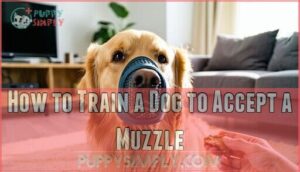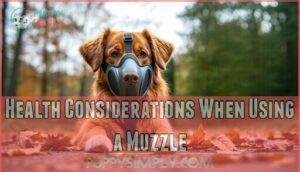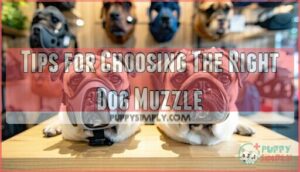This site is supported by our readers. We may earn a commission, at no cost to you, if you purchase through links.

Unlike cloth muzzles that restrict breathing, basket muzzles allow your dog to pant, drink water, and breathe freely while preventing noise complaints from neighbors.
They’re designed for temporary use during training or specific situations—not punishment.
Proper fit is essential: you should be able to slip two fingers under the strap.
Remember, muzzles address the symptom, not the root cause of barking.
Understanding why different muzzle types work better for specific situations can transform your approach to managing vocal pups.
Table Of Contents
- Key Takeaways
- Why Are Dog Muzzles So Controversial?
- When and How to Use a Dog Muzzle
- Different Types of Dog Muzzles
- How to Train a Dog to Accept a Muzzle
- Properly Fitting a Dog Muzzle
- Health Considerations When Using a Muzzle
- How to Measure and Fit a Dog Muzzle
- Tips for Choosing The Right Dog Muzzle
- Frequently Asked Questions (FAQs)
- What is the best muzzle to stop a dog from barking?
- What do vets recommend to stop dogs from barking?
- What is the best thing to use to stop a dog from barking?
- How can I tell if a muzzle is too tight or too loose on my dog?
- What should I do if my dog is scared of muzzles?
- Are there any laws or regulations regarding the use of muzzles?
- Can a muzzle be used as a substitute for proper dog training?
- Can muzzles completely eliminate excessive barking behavior?
- How often should muzzles be cleaned?
- What age can puppies start wearing muzzles?
- Conclusion
Key Takeaways
- Choose basket-style muzzles like the Baskerville Ultra – they’re the best for barking control because they allow your dog to pant, drink, and breathe freely, while preventing noise complaints, unlike restrictive cloth muzzles.
- Never use muzzles as punishment or permanent solutions – they address the symptom of barking, not the root cause, so you’ll need proper training and behavior modification to solve underlying issues.
- Proper fit is essential for safety and effectiveness – you should be able to slip two fingers under the strap, and your dog needs enough space to pant while the muzzle stays secure.
- Gradual training with positive reinforcement works best – introduce the muzzle slowly with treats and praise, rather than forcing it on, making the experience less stressful for your dog.
Why Are Dog Muzzles So Controversial?
Dog muzzles spark heated debates due to deep-rooted social stigma and public perception issues.
Many people associate muzzles with aggressive dogs, creating unfair judgments about both pets and their owners.
This animal rights controversy stems from misconceptions—muzzles aren’t punishment tools but essential safety devices.
Owner responsibility includes addressing dog barking solutions through proper training and equipment.
The best dog muzzle for barking represents effective anti barking devices when used ethically.
Understanding muzzle ethics helps combat negative stereotypes while prioritizing everyone’s safety and your dog’s well-being.
When and How to Use a Dog Muzzle
Understanding muzzle safety starts with knowing when they’re actually needed. You can’t just slap one on and hope for the best—timing and technique matter.
Muzzle safety isn’t about slapping one on and hoping—timing and technique make all the difference.
Three key situations for muzzle use:
- Emergency scenarios – Injured or frightened dogs may bite defensively
- Professional appointments – Vet visits or grooming when stress triggers aggression
- Behavior modification – Temporary tool during training for dogs with biting history
Best dog muzzles for barking control require proper dog behavior assessment first. Different muzzle materials serve different purposes—basket designs allow panting while soft wraps restrict it completely.
Your usage guidelines should prioritize safety over convenience. Training tips include gradual introduction with treats, never forcing the process. Stop dog barking humanely by pairing muzzles with positive reinforcement, not punishment.
Barking control devices work best when you understand why your dog’s vocalizing in the first place. Properly fitted dog muzzle types are essential for effective and safe use.
Different Types of Dog Muzzles
You’ll find several muzzle types designed to address barking while keeping safety and comfort in mind.
Each style serves different needs, from basket muzzles that allow full panting to soft wraps for short-term use during specific situations.
CollarDirect Leather Dog Muzzle
Crafted from full-grain genuine leather, the CollarDirect stands out among the best dog muzzles for its premium construction and reliable dog bark control.
This handmade leather muzzle combines traditional craftsmanship with modern safety features, making it perfect for Pitbulls and similar breeds requiring secure containment.
The basket design prioritizes dog comfort while maintaining muzzle safety through proper ventilation. Your pup can pant, drink water, and even accept treats—think of it as a safety net that doesn’t sacrifice basic needs.
The adjustable straps guarantee a snug fit without compromising circulation.
Leather care is straightforward: occasional conditioning keeps the material supple and extends muzzle durability. Before purchasing, measure your dog’s snout circumference and length from below the eyes to the nose tip. This attention to proper sizing transforms a potentially stressful experience into manageable protection during vet visits or public outings where breed-specific legislation applies.
This reliable dog bark control is essential for public safety, and with the CollarDirect, you can ensure your dog’s comfort and security. The handmade leather muzzle is a testament to traditional craftsmanship combined with modern safety features, providing a secure containment solution for Pitbulls and similar breeds. With its adjustable straps and proper ventilation, the CollarDirect is an excellent choice for dog owners seeking a premium muzzle.
Baskerville Ultra Dog Muzzle Tan
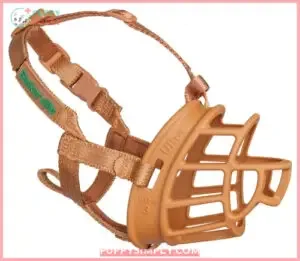
Champion of comfort and safety, the Baskerville Ultra Dog Muzzle delivers professional-grade protection without sacrificing your dog’s well-being.
This thermoplastic rubber muzzle allows complete panting, drinking, and treat-taking while preventing bites effectively.
You’ll appreciate its heat-moldable design that customizes to your dog’s unique snout shape using warm water.
The updated clip system makes application quick and secure, with optional locking mechanisms for extra peace of mind during high-stress situations.
Available in six sizes, this lightweight basket muzzle works perfectly for vet visits, grooming sessions, and training reactive dogs.
The padded straps prevent chafing, though some owners add extra padding for extended wear.
While not completely bite-proof against determined nibblers, it’s excellent for managing aggression and enabling safe socialization.
Regular inspection guarantees the best fit and safety.
Best For: Dogs with reactive tendencies or those needing safe socialization, vet visits, or grooming sessions while maintaining comfort and ventilation.
- Comfortable for long-term daily use, allowing panting, drinking, and treat access.
- Custom heat-moldable fit with multiple sizes for various breeds.
- Secure design with padded, adjustable straps and optional locking.
- Not fully bite-proof; determined dogs may chew through it.
- Difficult to clean thoroughly due to crevices trapping drool and debris.
- May cause rubbing or discomfort on the snout without extra padding.
Nylon Dog Muzzle Grey
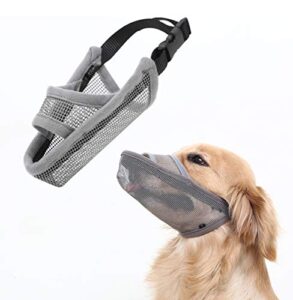
You’ll find the Nylon Dog Muzzle Grey offers practical protection without breaking the bank.
This lightweight, water-resistant design features reinforced stitching and extra nose padding for comfort during short-term use.
The easy-release snap buckle means you can secure it quickly—perfect for vet visits or grooming sessions when time matters.
While it prevents biting and scavenging, your dog can still pant and drink water safely.
The adjustable straps accommodate various head shapes, though proper measuring remains essential for effectiveness and comfort.
Best For: Owners needing a comfortable, secure solution for short-term use during walks, vet visits, or grooming for medium-sized dogs like Huskies and Border Collies.
- Lightweight, breathable design lets dogs pant and drink.
- Padded nose and adjustable straps for a secure, comfortable fit.
- Quick-release buckle makes it easy to put on and take off.
- Not meant for extended wear or hot weather.
- Some dogs may figure out how to scoop food or objects.
- Durability and fit may vary depending on dog’s breed and activity.
Soft Silicone Dog Muzzle
View On Amazon
Several soft silicone muzzles offer comfortable protection while maintaining breathability.
These lightweight, flexible designs allow your dog to pant, drink, and receive treats through basket-style openings.
However, they’re not bite-proof—determined dogs can fold or chew through the material.
The ergonomic design reduces chafing compared to rigid alternatives, making them ideal for short-term use during grooming or training sessions.
Always supervise your dog, as these muzzles work better as visual deterrents than absolute protection, and are suitable for short-term use.
Best For: Owners of small to extra-large, well-managed dogs needing comfortable, breathable restraint for short-term use during grooming, socialization, or training.
- Soft silicone is comfortable, lightweight, and reduces risk of chafing.
- Allows panting, drinking, and treat-giving through basket-style openings.
- Adjustable, secure fit with anti-slip straps and easy cleaning.
- Not bite-proof; determined or aggressive dogs can chew or fold the material.
- Sizing may be inconsistent across orders, requiring extra adjustments.
- Not suitable for emergency situations or as a primary tool for aggressive dogs.
Dog Muzzle Breathable
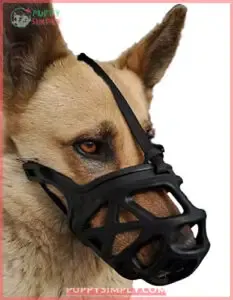
Why settle for a muzzle that restricts your dog’s natural behaviors?
Breathable muzzles feature mesh fabric construction and drink-thru designs that allow panting and hydration without removal.
These lightweight designs use soft silicone or transparent materials that reduce visibility stress while maintaining airflow through front openings and side vents.
The adjustable straps with secure buckles guarantee an escape-proof fit across breeds.
However, proper sizing remains critical—only 21.4% of owners achieve correct fit, and ill-fitting muzzles cause physical damage in 31% of dogs with frequent use.
When choosing a muzzle, consider the importance of breathable materials to guarantee the dog’s comfort and safety.
Best For: Owners of small to medium dogs needing a safe, breathable solution for training, socialization, or vet visits, especially when panting and drinking access are important.
- Only a small percentage of owners achieve a correct fit, raising risk of injury with improper sizing.
- Not recommended for flat-faced (brachycephalic) or highly anxious breeds.
- Some users report issues with strap length, material hardness, and sizing consistency.
- Breathable mesh and wide openings allow for natural panting, hydration, and treat feeding.
- Lightweight, soft materials and adjustable straps offer a comfortable, secure fit.
- Reduces anxiety and overheating risk compared to fabric or rigid muzzles.
Gentle Muzzle Guard Dogs
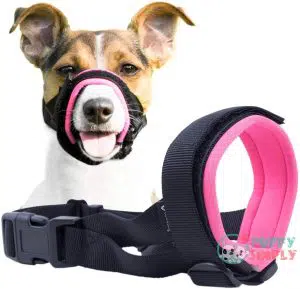
The GoodBoy Gentle Muzzle Guard prevents biting, unwanted chewing, and excessive barking while allowing unrestricted breathing, panting, and drinking.
Made with soft neoprene padding, it’s available in four sizes and three colors, priced between $16-$19.
Its adjustable straps guarantee a secure fit, though you’ll need to regularly check for proper positioning to prevent chafing during extended use, ensuring the muzzle remains a secure fit.
Best For: Owners seeking a humane, adjustable solution to manage their dog’s barking, chewing, or biting during walks or training.
- Allows panting, breathing, and drinking, making it safe for short-term use and humane behavior management.
- Soft neoprene padding and adjustable straps provide comfort and minimize chafing.
- Easy-to-fit design with multiple sizes and colors, suitable for most breeds.
- Some dogs may initially resist wearing it or need gradual training for acceptance.
- Mixed durability reports; may not withstand heavy or aggressive use.
- Requires careful measurement and frequent adjustment to ensure a proper, chafe-free fit.
Ewinever Dog Muzzles Adjustable
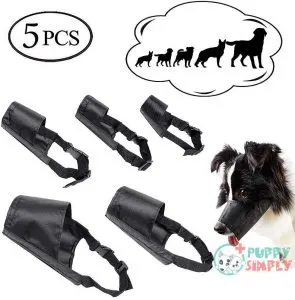
The Ewinever Dog Muzzles Adjustable set provides budget-conscious pet owners with a practical solution for managing barking and other behavioral issues.
This 5-piece nylon muzzle collection offers impressive value, especially for growing puppies who’ll quickly outgrow a single size.
You’ll appreciate the quick-release buckles and adjustable straps that create a customizable fit for your dog’s comfort.
The breathable design allows normal panting and drinking—essential for your pet’s wellbeing during wear.
These muzzles effectively prevent biting, chewing, and excessive barking while maintaining your dog’s ability to breathe freely.
However, don’t expect premium durability.
Some users report stitching issues and find the straps too short for larger breeds.
You’ll want to attach the muzzle to your dog’s collar for added security, as determined pups can sometimes work them off.
For temporary behavioral management during training, vet visits, or grooming sessions, these affordable muzzles deliver solid performance without breaking the bank.
Best For: Budget-conscious dog owners needing adjustable, temporary muzzles for training, vet visits, or grooming.
- Durability concerns due to stitching and material quality
- Straps may be too short for larger breeds
- Some dogs can remove the muzzle unless it’s attached to a collar
- Affordable 5-piece set covers multiple sizes for growing dogs
- Quick-release buckles and adjustable straps for a secure, custom fit
- Breathable nylon design allows dogs to pant and drink
How to Train a Dog to Accept a Muzzle
Training your dog to accept a muzzle requires patience and a gradual approach. Think of it as introducing a new piece of clothing – you wouldn’t force someone into a suit without letting them see it first. Muzzle introduction should always start with positive associations, never as punishment.
Begin dog muzzle training by letting your pup sniff and investigate the muzzle while offering treats. This muzzle desensitization process builds trust. Next, hold the muzzle near their face for brief moments, rewarding calm behavior. Dog muzzle acclimation happens in small steps – don’t rush the process.
Key training techniques include:
- Reward every positive interaction – treats, praise, and play make muzzles less scary
- Practice short sessions daily – five minutes beats one stressful hour
- Never force the muzzle on – let your dog choose to put their nose in voluntarily
Dog muzzle introduction works best when you pair it with favorite activities. Use positive reinforcement consistently – your dog should associate the muzzle with good things happening. These muzzle training techniques create lasting comfort rather than temporary compliance.
Properly Fitting a Dog Muzzle
Getting the right fit prevents escape attempts and ensures your dog’s safety.
Start with accurate snout measurement – measure circumference at the widest point behind the nose, then length from eye level to nose tip.
Check that the muzzle allows two fingers’ width of mouth space for panting and drinking.
Adjust straps snugly but not tight – you should fit one finger under each strap.
Test fit adjustment by ensuring your dog can open their mouth slightly.
Proper muzzle sizing means the nose doesn’t touch the front, preventing rubbing.
Remember, muzzle comfort directly impacts your dog’s acceptance and the muzzle’s effectiveness for barking control.
Understanding the correct dog muzzle size is vital for a proper fit, which involves considering the muzzle size charts to guarantee accuracy.
Health Considerations When Using a Muzzle
Using a muzzle safely requires careful attention to your dog’s breathing and circulation.
You’ll need to take into account both the immediate physical effects and the broader legal implications of muzzle use in your area.
Breathing and Panting
Beyond ensuring proper fit, your dog’s ability to breathe freely determines whether a muzzle becomes a helpful tool or a health hazard.
Breathable Materials like mesh and perforated designs allow essential Airflow Design that prevents overheating.
Basket-style muzzles excel here – their open structure provides ample Panting Space while maintaining security.
Soft sleeve muzzles often restrict Mouth Movement, blocking your dog’s natural cooling system.
Think of panting as your pup’s built-in air conditioner – without it, they’ll overheat fast.
Quality Ventilation Systems in modern muzzles feature strategic openings that promote airflow without compromising control.
Watch for excessive panting or labored breathing while your dog wears the muzzle.
These red flags signal immediate removal.
Brachycephalic breeds (flat-faced dogs) need extra attention since they already struggle with breathing.
Choose muzzles with superior dog muzzle ventilation to keep your furry friend comfortable and safe during use.
Ensuring the right muzzle fit guide is crucial for your dog’s comfort and safety.
Legal and Ethical Considerations of Muzzle Use
While proper breathing matters, understanding muzzle laws and ethical use proves equally important for responsible pet ownership. Over 1,000 U.S. cities enforce breed-specific legislation requiring muzzles, making regulatory compliance essential for public safety.
Ethical muzzle training prioritizes animal rights through positive reinforcement rather than punishment. Consider these key factors for dog behavior correction:
- Never use muzzles to silence dogs out of convenience
- Guarantee proper fit prevents skin irritation and psychological stress
- Limit wear time to avoid overheating during necessary situations
- Monitor your dog for signs of distress or discomfort
Muzzle effectiveness depends on addressing root behavioral issues alongside safety measures. You’re not just following rules—you’re protecting your dog and community while respecting animal welfare standards that make muzzle safety meaningful. Effective muzzle for dogs training is indispensable for ensuring the well-being of your pet.
How to Measure and Fit a Dog Muzzle
Since accurate muzzle sizing determines your dog’s comfort and safety, you’ll need precise measurements before making any purchase.
Start by measuring your dog’s snout length from the tip of their nose to just below their eyes, then measure the circumference around the widest part of their muzzle.
Here’s your step-by-step dog muzzle measurement process:
- Snout measurement: Use a soft measuring tape for length and circumference
- Fit adjustment: Add 0.5 inches to both measurements for proper breathing space
- Comfort factors: Confirm the muzzle allows panting, drinking, and treats
- Dog anatomy: Consider your pet’s breed-specific snout shape and size
- Muzzle sizing: Check manufacturer sizing charts against your measurements
Most manufacturers provide detailed sizing guides, but these measurements guarantee dog muzzle comfort and prevent dangerous restriction of airflow.
Remember that experts advocate muzzle training for puppies to guarantee safety and adaptability.
Tips for Choosing The Right Dog Muzzle
Now that you’ve got the right measurements, choosing the perfect dog muzzle becomes much easier.
The key is matching your dog’s specific needs with the right features and materials.
Key Selection Factors:
- Muzzle Materials: Leather offers durability for strong dogs, while soft silicone provides comfort for sensitive pups
- Breed Considerations: Flat-faced breeds need specialized short-snout designs, while long-nosed breeds can use standard basket styles
- Safety Features: Look for adjustable straps, secure buckles, and emergency quick-release options
- Muzzle Comfort: Padded edges and breathable designs prevent chafing during extended wear
Your dog’s temperament matters too. Anxious dogs benefit from softer materials, while determined escape artists need reinforced construction.
Best dog muzzles for barking should allow panting and drinking while effectively reducing noise. Consider your primary use – vet visits need different features than daily walks.
Dog bark control works best when you can still reward good behavior with treats through the muzzle openings. When selecting a muzzle, consider the various dog muzzle types available to guarantee the best fit for your pet.
Frequently Asked Questions (FAQs)
What is the best muzzle to stop a dog from barking?
The early bird catches the worm, and the right muzzle catches excessive barking.
You’ll want the Baskerville Ultra Muzzle for stopping barking while allowing comfortable panting, drinking, and breathing—it’s durable, lightweight, and prevents vocalization effectively, making it a great choice for effective control.
What do vets recommend to stop dogs from barking?
Vets typically recommend positive reinforcement training, anti-anxiety medication, or behavioral therapy rather than muzzles for barking. Muzzles address safety concerns but won’t solve the underlying cause of excessive barking behavior.
What is the best thing to use to stop a dog from barking?
Training works best for long-term bark control. You’ll need consistent positive reinforcement, identifying triggers, and teaching "quiet" commands. For immediate situations, basket muzzles allow panting while preventing excessive barking safely.
How can I tell if a muzzle is too tight or too loose on my dog?
Ironically, the perfect muzzle fit feels like your dog’s wearing nothing at all.
Check that you can slide two fingers between the muzzle and your dog’s face, ensuring they can pant freely but can’t slip out.
What should I do if my dog is scared of muzzles?
Start with positive associations by letting your dog sniff the muzzle while offering treats.
Gradually introduce short wearing sessions, rewarding calm behavior.
Never force it on—patience and consistency help dogs overcome their fear naturally.
Are there any laws or regulations regarding the use of muzzles?
Twenty-five states mandate muzzles for specific breeds—you’ll need to check local ordinances. Many areas require muzzles on designated dangerous breeds or individual dogs with bite histories during public outings.
Can a muzzle be used as a substitute for proper dog training?
No, muzzles can’t replace proper training.
They’re temporary safety tools that address symptoms, not root causes.
You’ll still need consistent training, positive reinforcement, and possibly professional help to fix underlying behavioral issues permanently, which requires consistent effort.
Can muzzles completely eliminate excessive barking behavior?
No, muzzles don’t eliminate excessive barking permanently.
They temporarily prevent the sound while worn, but won’t change your dog’s underlying motivation to bark.
You’ll need consistent training to address the root behavioral causes for lasting results, focusing on the root issues.
How often should muzzles be cleaned?
Clean your dog’s muzzle after each use with warm, soapy water.
Weekly deep cleaning prevents bacteria buildup and odors.
Check for cracks or wear during cleaning—damaged muzzles compromise safety and comfort.
What age can puppies start wearing muzzles?
Most experts recommend waiting until puppies are at least 14-16 weeks old before introducing muzzles. You’ll need to make certain of proper fit and gradual training for safety and comfort.
Conclusion
Managing your pup’s "vocal enthusiasm" requires the right approach and equipment.
The best dog muzzle for barking combines safety, comfort, and effectiveness—basket-style options like the Baskerville Ultra lead the pack.
Remember, you’re addressing the symptom while working on underlying behavioral issues.
Proper training, gradual introduction, and correct sizing guarantee success.
Never use muzzles as punishment or long-term solutions.
When chosen thoughtfully and used responsibly, the right muzzle helps maintain neighborhood harmony while protecting your dog’s wellbeing during training.


